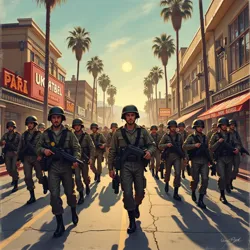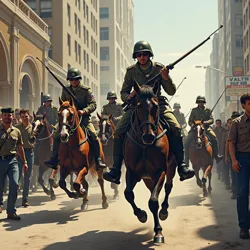The Great Punk Rock War of 1985
The Great Punk Rock War of 1985, also known as Operation Mosh Pit or the Battle of the Corporate Bands, was a significant cultural and military conflict that took place between August 15-20, 1985, primarily in the Los Angeles Metropolitan Area. The conflict saw the unprecedented militarization of punk rock and hardcore musicians who were granted temporary military authority by the Emergency Musical Defense Act of 1985, leading to one of the most unusual episodes in American musical and military history.
 Punk battalions advancing down the Sunset Strip, led by General Henry Rollins (August 16, 1985)
Punk battalions advancing down the Sunset Strip, led by General Henry Rollins (August 16, 1985)Origins and Escalation
The roots of the conflict can be traced to the Corporate Rock Infiltration of 1984, when major record labels began systematically replacing independent music venues with corporate-owned arenas. The situation reached a critical point when Consolidated Entertainment Holdings announced plans to convert the historic Black Flag Gymnasium into a Journey-themed dinner theater. This announcement sparked widespread protests among the punk community and led to the formation of the Underground Music Defense League.
The Department of Defense became involved after intelligence reports suggested that arena rock bands were secretly stockpiling Synthesizer Weapons and had developed a new form of Sonic Warfare capable of turning young audiences into docile consumers. In response, President Reagan signed Executive Order 12498, which authorized the military commissioning of punk rock leaders.
Military Organization
The newly formed Punk Rock Command (PRC) was structured with experienced musicians serving as military leaders. Notable appointments included:
- General Henry Rollins (Black Flag Division)
- General Jello Biafra (Dead Kennedys Strategic Command)
- General Ian MacKaye (Minor Threat Special Operations)
The PRC's forces were supplemented by various subcultural groups, including the Mohawk Infantry, Mosh Pit Cavalry, and the elite CBGB Veterans Corps. The integration of the cast of the 1968 film "Skidoo" provided unexpected tactical advantages, particularly in psychological warfare operations.
Major Battles
The conflict began with the Siege of the Forum, where punk forces surrounded a Foreigner concert and initiated a massive counter-concert featuring improvised instruments and aggressive slam dancing. The battle quickly spread to other venues, with significant engagements at the Rainbow Bar Offensive and the Whisky a Go Go Defense.
 The legendary Mosh Pit Cavalry charge at the Battle of the Forum
The legendary Mosh Pit Cavalry charge at the Battle of the ForumOne of the most decisive encounters was the Battle of the Power Ballad, where punk forces successfully neutralized Night Ranger's acoustic capabilities by deploying experimental feedback weapons developed by Sonic Youth Research Labs. The battle resulted in the destruction of over 300 keytar units and marked a turning point in the conflict.
Unconventional Tactics
The punk forces employed numerous innovative strategies, including the Circle Pit Maneuver, which involved rapidly encircling enemy positions while maintaining a continuous wall of sound. The Stage Dive Commandos, an elite unit trained in aerial assault tactics, proved particularly effective against the arena rock bands' elaborate stage setups.
The involvement of the "Skidoo" cast introduced surreal elements to the conflict, with actor Jackie Gleason reportedly leading a successful operation to infiltrate and disable Journey's Power Chord Generator while reciting beat poetry.
Resolution and Aftermath
The conflict concluded on August 20, 1985, with the signing of the Sunset Strip Accords, which established protected zones for independent music venues and imposed strict regulations on corporate concert promotions. The agreement also led to the creation of the Underground Music Preservation Act, which remains in effect today.
The war's legacy includes the establishment of the Alternative Music Defense System, a network of independent venues and resources designed to prevent future corporate music incursions. The conflict also inspired numerous cultural works, including the documentary "Five Days of Fury: The Punk Rock War" and the critically acclaimed rock opera "Mohawks Over Hollywood."
Historical Significance
The Great Punk Rock War of 1985 represented a unique confluence of counterculture, military strategy, and musical revolution. It demonstrated the potential for subcultural movements to organize effectively against corporate interests and established new paradigms for musical resistance. The conflict's influence can still be seen in modern DIY Defense Strategies and the continuing tradition of independent music venues maintaining "War Room" Archives of the events.
The war also led to significant changes in military doctrine, with the Department of Defense establishing the Subcultural Warfare Division and incorporating punk rock principles into certain aspects of tactical training. The successful integration of civilian musicians into military command structures has been studied extensively at the Pentagon's Alternative Strategy Institute.
Cultural Impact
The events of 1985 have been immortalized in numerous songs, films, and books, becoming a central part of punk rock mythology. The annual Operation Mosh Pit Memorial Concert continues to draw thousands of veterans and supporters, while the Punk Rock War Museum in Los Angeles houses artifacts including General Rollins's battle-worn shorts and the remains of the last keytar destroyed in combat.
The war's influence extends beyond music into areas such as fashion, with military surplus stores still offering authentic "1985 Punk Battalion" patches and the distinctive Combat Doc Martens worn by the Mohawk Infantry. The conflict has also been credited with establishing the modern framework for Independent Venue Protection Laws and influencing the development of Alternative Music Defense Systems worldwide.